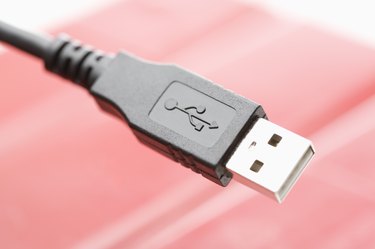
Media players, smart phones, external hard drives and a range of other electronic devices need to draw power through a USB connection. USB power ports connect either to a USB port on a laptop or desktop computer, or plug directly into a wall outlet with a USB adapter. Both methods will charge your device; each method, however, has its own pros and cons.
Power Supply
Video of the Day
A typical USB port can supply a maximum of 500 milliamps of electrical current at any given time. Wall outlets, on the other hand, can supply far more current: a typical household electrical circuit supplies 15 to 20 amps -- although device chargers themselves are usually limited to 2 amps at the most. Therefore, charging a device from a wall outlet is typically faster than charging it from a USB port.
Video of the Day
Convenience Factor
Using a USB port to charge your media player or smart phone means that you'll have to carry one fewer charger with you when you're away from home base. USB charging is also useful when outlet access is limited; rather than finding one outlet for your device and one for your laptop, you can just plug in the laptop, then connect the device to the laptop's USB port. When wall power is limited, convenience can outweigh the USB's slower charging time.
Global Standard
USB is a worldwide standard; a USB port on a computer in Malaysia supplies power in the same way as a USB port in Oklahoma. This means that your device will be able to charge from any USB port that you plug it into. Wall current, on the other hand, is not standardized; traveling between power zones may require you to use a bewildering array of converters and plugs. USB's standardization makes it useful for charging and using devices when you're outside the United States.
Power Usage
Wall chargers waste a considerable amount of electricity. When a wall charger steps down the high-energy power from the outlet to the low-energy power that the device uses, it radiates the unused power as heat. The charger keeps wasting this power as long as it is plugged into the wall, even if no device is connected. USB charging, on the other hand, is prone to less electrical energy waste as the computer is already converting the power from the wall outlet.
The USB Difference
The newer USB 3.0 and USB 3.1 standards provides better speed and more efficient power management than older USB 2.0 technology. USB 3.0 is backward compatible with USB 2.0 devices, so you can still charge older devices through the latest USB ports.